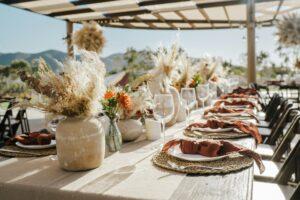Planning a wedding can feel like a second job—especially when you’re juggling venues, vendors, and 200 questions from Aunt Linda. But with the right roadmap and a bit of insider know-how, it becomes a lot less overwhelming. Chris Epps has spent over 15 years helping couples plan weddings across Charlotte, NC, and if there’s one thing he’s learned, it’s this: the couples who stay focused on what really matters enjoy the process a whole lot more.
This guide breaks down how to plan a wedding in simple, actionable steps—while pointing you to deep-dive resources for each phase. Whether you’re planning a black-tie ballroom bash or an intimate backyard ceremony, this is where it all comes together.
Step 1: Set Your Vision and Budget
Before browsing dresses or tasting cakes, take time to define the kind of wedding you want. Your vision drives every decision—budget included.
Start with questions like:
- What kind of atmosphere do we want? Formal, relaxed, quirky, classic?
- How many guests are we inviting? A 40-person brunch wedding is very different from a 200-person evening event.
- What are our top 3 non-negotiables? (Venue, food, photography, etc.)
Once your vision is clear, set a budget you can actually stick to. Be realistic about what things cost in your area, and leave room for hidden fees like taxes, service charges, tips, and delivery fees.
One smart move: build a “reserve” line in your budget for unexpected costs like last-minute heaters, linen upgrades, or extra staffing for large events.
If money’s tight, don’t worry—we’ve got a full post on how to plan a wedding on a budget that shows you how to stretch every dollar.
Step 2: Decide on the Type of Wedding You Want

Your guest count, location, and tone shape everything. Do you want:
- A small, personal ceremony with 20 guests?
- A full-scale destination wedding?
- A backyard celebration with friends and food trucks?
A smaller wedding doesn’t always mean easier—but it does open up more creative freedom. Fewer guests often means more time to personalize the experience. Check out our full breakdown of small wedding ideas to spark inspiration.
And if you’re considering tying the knot somewhere far from home, we’ve outlined everything you need in how to plan a destination wedding, including legal, logistical, and guest communication tips.
Step 3: Choose Your Date and Book the Venue
Some couples choose a date based on sentiment—a meaningful anniversary or favorite season. Others work backward from venue availability. Either is fine, as long as you consider:
- Climate: Summer weddings outdoors in the South? Think shade and backup plans.
- Local events: A big festival or sports game in town can eat up hotel blocks.
- Vendor availability: Planners, photographers, and florists often book out 12–18 months in advance.
When booking your venue, always ask what’s included. Some offer tables, chairs, or even linens. Others provide just the space.
If you’re eyeing an outdoor location, don’t miss our guide on outdoor wedding venue ideas. From vineyards to courtyards to private homes, there are more options than you think—and each one comes with its own quirks (and weather plans).
Step 4: Create a Wedding Planning Timeline
Wondering how long does it take to plan a wedding? The sweet spot is usually 12 to 18 months, but you can pull it off in less if you’re decisive and organized.
Here’s a simplified planning window:
- 12 months out: Book venue, planner, major vendors
- 9 months out: Lock in photographer, caterer, entertainment
- 6 months out: Finalize guest list, send Save the Dates
- 3 months out: Confirm details, finalize décor
- 1 month out: Final walk-through, seating chart, vendor confirmations
The timeline gets tighter closer to the big day, so front-load decisions wherever possible. For a full breakdown, check our wedding planning checklist and wedding reception timeline to stay on track.
Step 5: Book Your Core Vendors Early
Book your must-haves first:
- Venue
- Planner or day-of coordinator
- Photographer/videographer
- Caterer
- Entertainment
- Hair/makeup
- Florist
Do your research. Ask to see full galleries—not just Instagram highlights. And read contracts carefully: how many hours are included? Do they charge for setup time?
If you’re wondering about costs, especially for support like planners, read how much is a wedding planner to decide what level of help you need—and what you can afford.
Step 6: Plan the Ceremony Details

The ceremony sets the emotional tone for the day. Whether you’re going the traditional route or planning something totally personal, a few details matter:
- Choose an officiant who reflects your style and values
- Decide whether to write your own vows or use traditional ones
- Add personal elements like handfasting, unity candles, or cultural rituals
For fresh, creative inspiration, browse our full guide to unique wedding ceremony ideas. Just remember: meaningful always beats flashy.
Step 7: Design the Reception Experience
Your reception is the party—and it works best when guests always know what’s happening next.
Nail the flow with these ideas:
- Start with a welcoming cocktail hour to ease into the event
- Keep dinner service efficient (especially with a big crowd)
- Use short speeches and toasts to hold attention—not stall the timeline
- Make space for dancing, mingling, and quiet corners for conversations
Need more? Fun wedding reception ideas and cheap wedding reception ideas offer tons of creative ways to make the night memorable without spending a fortune.
If you’re feeling overwhelmed by the order of events, wedding reception timeline breaks down a smooth flow from first dance to final farewell.
Step 8: Build a Wedding Menu That Works
Wedding food matters—and not just because it’s delicious. It’s a central part of guest experience, and how it’s served affects everything.
From food stations to late-night snacks, your catering plan should be practical, timely, and tailored to your vibe. Our detailed guide on wedding food ideas covers:
- Food styles that actually work at weddings (plated, buffet, stations, etc.)
- How to serve a crowd without chaos
- Budget-friendly options that still feel elevated
- Dessert alternatives (you don’t have to do cake)
Late-night snacks = morale boosters after hours of dancing. Think mini grilled cheese, sliders, or even cookies and milk.
Step 9: Stay Organized and Keep Stress Down
Even the chillest couples get overwhelmed. The secret isn’t avoiding stress—it’s managing it well.
Here’s what helps:
- Use a shared digital checklist with your partner
- Make decisions early and avoid second-guessing
- Have a trusted point person (friend or coordinator) for day-of logistics
- Schedule a real break the day before—not errands
If you’re aiming for a calm lead-up, don’t miss our post on how to plan a wedding without stress. It’s full of smart, real-world strategies that have worked for hundreds of couples.
Final Thoughts
At the end of the day, learning how to plan a wedding isn’t about perfection—it’s about making intentional choices that reflect your relationship, your priorities, and the kind of celebration you want to have.
The more you front-load decisions and lean on pros who know the ropes, the more you’ll enjoy every part of the journey. Trust your gut, ask good questions, and don’t forget to eat your own appetizers.
We’ve linked every step to its deeper guide—because you deserve real support, not just another checklist.


